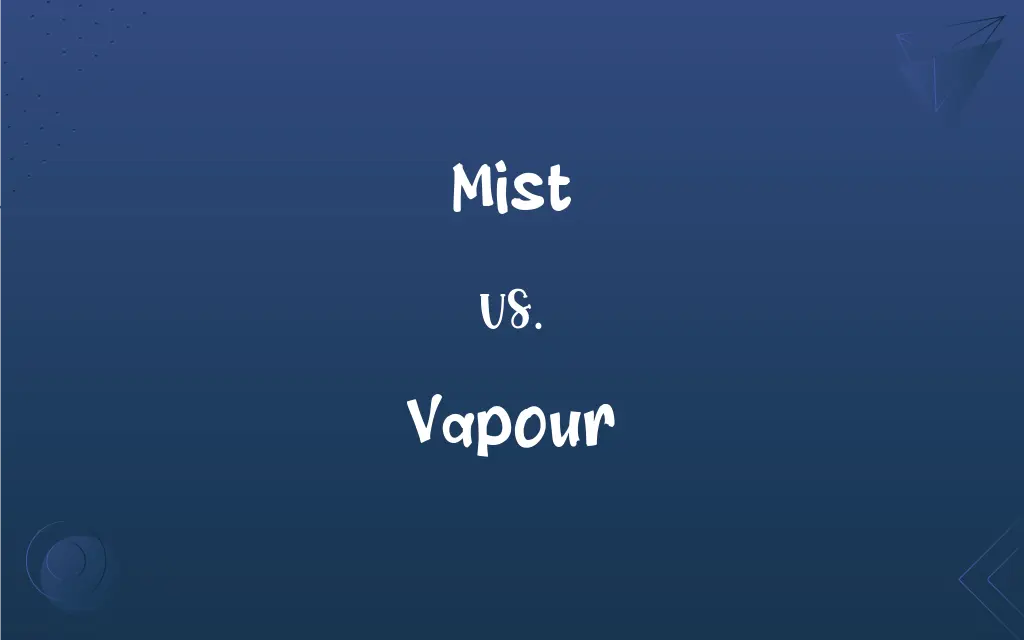Mist vs. Vapour: What's the Difference?
Edited by Harlon Moss || By Janet White || Updated on September 26, 2023
Mist is a collection of tiny water droplets in the air, while vapor is gaseous particles from substances that are normally liquid or solid at room temperature.

Key Differences
Mist and vapour are both related to the presence of particles in the air but have different compositions and occurrences. Mist is formed from tiny liquid water droplets suspended in the air, often resulting from the condensation of water vapor in the atmosphere. It usually occurs when the air is cool, and relative humidity is high, leading to visibility being reduced in more severe cases, showcasing its property as a phenomenon of weather or atmospheric condition.
Vapour, conversely, refers to the gaseous phase of a substance that is typically found in a liquid or solid state at room temperature. It arises from the process of evaporation or sublimation and is not bound to water alone. It encompasses gaseous forms of various substances, illustrating its broader application in representing the gaseous state of different elements and compounds.
Mist typically manifests as a visible phenomenon, with the tiny water droplets reflecting light, making it perceptible to the human eye. It is commonly seen in nature during specific weather conditions or microclimates, such as early in the morning or in areas with significant temperature differences, signifying its occurrence due to natural environmental conditions.
Vapour, however, is usually invisible, becoming visible only when it condenses into tiny liquid droplets, forming mist or clouds. It is not dependent on specific weather conditions and can arise from any substance that undergoes evaporation or sublimation. Vapour is integral to the understanding of states of matter, depicting the transition of substances from liquid or solid to gas.
Understanding the distinctions between mist and vapour is essential for distinguishing between the different states and forms of matter in the atmosphere. While mist is observable and specifically related to water droplets in the air, vapour is invisible and represents the gaseous form of various substances, showcasing the diversity and complexity of matter interactions in the environment.
ADVERTISEMENT
Comparison Chart
Definition
A collection of tiny water droplets suspended in the air.
The gaseous phase of substances normally liquid or solid.
Composition
Made of water droplets.
Comprises gaseous particles of various substances.
Visibility
Usually visible.
Generally invisible until it condenses.
Occurrence
Related to specific weather conditions or atmospheric changes.
Arises from evaporation or sublimation of any suitable substance.
Form
Liquid droplets in the air.
Gas particles in the air.
ADVERTISEMENT
Mist and Vapour Definitions
Mist
A thin fog with droplets of water.
The hills were shrouded in a light mist.
Vapour
The gaseous form of substances normally found in a liquid or solid state.
Water vapour is a significant greenhouse gas.
Mist
A phenomenon reducing visibility due to suspended water droplets.
A dense mist settled over the harbor, obscuring the ships.
Vapour
Invisible gas particles produced by evaporation or sublimation.
The vapour from the hot tea was barely visible.
Mist
A spray of liquid droplets.
She used a mist of rosewater to freshen her face.
Vapour
The gaseous phase of a substance at a temperature below its critical temperature.
The air was humid, filled with the vapour of the sea.
Mist
A mass of fine droplets of water in the atmosphere near or in contact with the earth.
Vapour
A substance diffused or suspended in the air.
The room was filled with the sweet vapour of jasmine.
Mist
Water vapor condensed on and clouding the appearance of a surface.
Vapour
A visible exhalation, such as mist or steam.
The kettle released a vapour into the cool air.
Mist
Fine drops of a liquid, such as water, perfume, or medication, sprayed into the air.
Vapour
Variant of vapor.
Mist
A suspension of fine drops of a liquid in a gas.
Vapour
A visible suspension in the air of particles of some substance
Mist
Something that dims or conceals.
Vapour
The process of becoming a vapor
Mist
A haze before the eyes that blurs the vision.
Mist
Something that produces or gives the impression of dimness or obscurity
The mists of the past.
Mist
A drink consisting of a liquor served over cracked ice.
Mist
To be or become obscured or blurred by or as if by mist.
Mist
To rain in a fine shower.
Mist
To conceal or veil with or as if with mist.
Mist
To moisturize (plants or dry air, for example) with a fine spray of water.
Mist
Water or other liquid finely suspended in air. fog, haze.}}
It was difficult to see through the morning mist.
Mist
(countable) A layer of fine droplets or particles.
There was an oily mist on the lens.
Mist
(figurative) Anything that dims, darkens, or hinders vision.
Mist
To form mist.
It's misting this morning.
Mist
To spray fine droplets on, particularly of water.
I mist my tropical plants every morning.
Mist
To cover with a mist.
The lens was misted.
Mist
(of the eyes) To be covered by tears.
My eyes misted when I remembered what had happened.
Mist
To disperse into a mist, accompanying operation of equipment at high speeds.
Mist
Visible watery vapor suspended in the atmosphere, at or near the surface of the earth; fog.
Mist
Coarse, watery vapor, floating or falling in visible particles, approaching the form of rain; as, Scotch mist.
Mist
Hence, anything which dims or darkens, and obscures or intercepts vision.
His passion cast a mist before his sense.
Mist
To cloud; to cover with mist; to dim.
Mist
To rain in very fine drops; as, it mists.
Mist
A thin fog with condensation near the ground
Mist
Become covered with mist;
The windshield misted over
Mist
Make less visible or unclear;
The stars are obscured by the clouds
Mist
Spray finely or cover with mist
Mist
Tiny water droplets suspended in the air.
The morning mist made the forest seem enchanting.
Mist
Condensed water vapor creating a cloudy appearance.
The mist on the window made it hard to see outside.
FAQs
Is mist a type of vapour?
Mist can be considered a visible form of vapour when the vapour condenses into tiny liquid droplets.
Can vapour refer to any gaseous substance?
Yes, vapour refers to the gaseous state of substances typically solid or liquid at room temperature.
Is mist always visible?
Mist is typically visible due to the reflection of light off the water droplets.
Is vapour visible to the human eye?
Vapour is usually invisible and only becomes visible when it condenses into liquid droplets.
Is mist always composed of water droplets?
Yes, mist is specifically a collection of tiny water droplets in the air.
Can mist occur indoors?
Yes, mist can occur indoors under conditions of high humidity and temperature differences.
Is vapour always related to water?
No, vapour can be the gaseous form of any substance that can evaporate or sublimate.
Can vapour form from solid substances?
Yes, vapour can form from solid substances through a process called sublimation.
Can we see mist in hot climates?
Yes, mist can occur in hot climates, especially in areas with significant temperature fluctuations and high humidity.
Does mist always affect visibility?
While mist often affects visibility, its impact can vary from a slight haze to a dense fog.
Can vapour be harmful?
Vapour can be harmful or harmless, depending on the substance it originates from.
Does mist only occur in specific climates?
While more common in certain climates, mist can occur in a variety of weather conditions and temperatures.
How is vapour different from gas?
While all vapour is gas, not all gas is vapour; vapour refers specifically to the gaseous state of substances typically solid or liquid at room temperature.
Can vapour exist in varying temperatures?
Yes, different substances have different temperatures at which they turn into vapour.
How is mist different from fog?
Mist and fog are similar, but fog is denser and reduces visibility more than mist.
About Author
Written by
Janet WhiteJanet White has been an esteemed writer and blogger for Difference Wiki. Holding a Master's degree in Science and Medical Journalism from the prestigious Boston University, she has consistently demonstrated her expertise and passion for her field. When she's not immersed in her work, Janet relishes her time exercising, delving into a good book, and cherishing moments with friends and family.
Edited by
Harlon MossHarlon is a seasoned quality moderator and accomplished content writer for Difference Wiki. An alumnus of the prestigious University of California, he earned his degree in Computer Science. Leveraging his academic background, Harlon brings a meticulous and informed perspective to his work, ensuring content accuracy and excellence.































































